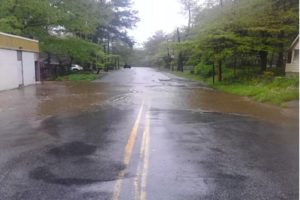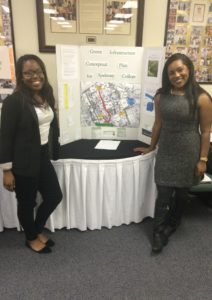ECO-Action recently completed a project that established a collaborative, educational framework for Green Infrastructure (GI) within the Atlanta University Center (AUC). From June 2014 through August 2016, through workshops, field trips, community forums, and classroom instruction, more than 350 students contributed to plans to alleviate pervasive storm water flooding around AUC.
 With the assistance of its partners, ECO-Action helped students integrate Green Infrastructure practices into a series of substantive recommendations. The two-year effort culminated in the work of 27 students who developed nine Conceptual Plans to capture storm water from AUC campuses as well as surrounding properties that drain onto the AUC campuses.
With the assistance of its partners, ECO-Action helped students integrate Green Infrastructure practices into a series of substantive recommendations. The two-year effort culminated in the work of 27 students who developed nine Conceptual Plans to capture storm water from AUC campuses as well as surrounding properties that drain onto the AUC campuses.
Students were able to use this headwater of Proctor Creek as a living laboratory for development of best practices such as water testing, GIS analyses, and site mapping for green infrastructure. The initiative was funded primarily through EPA’s Urban Waters Program, which seeks to “help local residents and their organizations, particularly those in under-served communities, restore their urban waters in ways that also benefit community and economic revitalization.”
 “Being involved in planning and hopefully implementing GI throughout my community has been such an insightful experience.” said Spelman student Sydney Hubbert. “I feel I am able to give back to my community in a way that will last generations and possibly spur even more GI methods throughout the community, nation, and world.”
“Being involved in planning and hopefully implementing GI throughout my community has been such an insightful experience.” said Spelman student Sydney Hubbert. “I feel I am able to give back to my community in a way that will last generations and possibly spur even more GI methods throughout the community, nation, and world.”
Early in their research, students documented the adverse effects that combined sewage – storm water mixed with raw sewage – flooding downhill from the AUC campuses has on public health in the lower elevation residential communities and on water quality in Proctor Creek. They took it as a moral responsibility to develop capacity relief for the combined sewer system to reduce the adverse impacts that flooding from the AUC campuses has on downstream public health.
In line with the notion that nature can help make cities healthier, more resilient and more appealing places to live, the students also recognized that introducing storm water storage greenways to the AUC campuses could improve aesthetics and provide passive recreation opportunities and play spaces. One Conceptual Plan notes that, “running water releases negative ions into its surroundings which mediate mood and improve creativity….” Other research states, “walking in nature changes brain chemistry in a positive way, in such a way as to reduce violence and improve attitude.”
 “We developed plans that not just mitigated, retained, and detained storm water, but we envisioned a future community and environment that is sustainable, healthy, and progressive.” said student Sederra Ross of Clark Atlanta University.
“We developed plans that not just mitigated, retained, and detained storm water, but we envisioned a future community and environment that is sustainable, healthy, and progressive.” said student Sederra Ross of Clark Atlanta University.
Students recommended that their Conceptual Plans be considered for implementation not only to improve livability at AUC, but also to ensure improved living conditions for all affected downstream communities. Additional long-term benefits the students expect include increased systems resiliency, cleaner air and water, collection of water for reuse and for drought, and a way to lessen the impact of climate change.
The students noted that implementation of their Conceptual Plans will require having someone to nurture collaboration and cooperation among the private and public stakeholders. Once the stakeholders agree to move forward, more complex hydrological analysis will be necessary along with cost/benefit analyses.
These issues, and others in Vine City, English Avenue, other metro-Atlanta communities and other rural Georgia communities are far from concluded. While we celebrate this success, we recommit to standing strong together.


